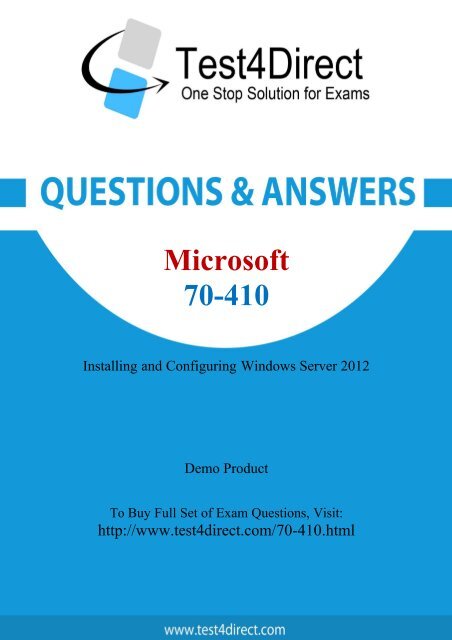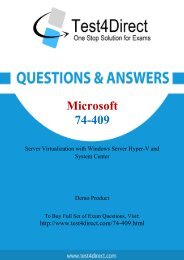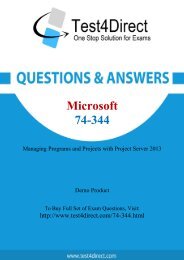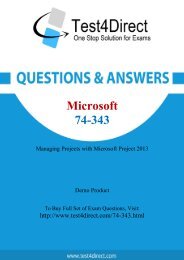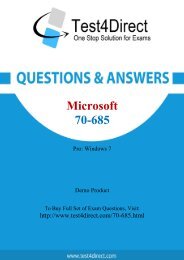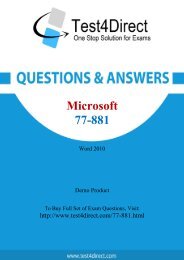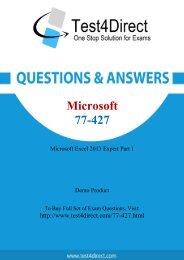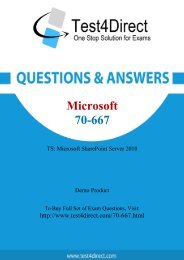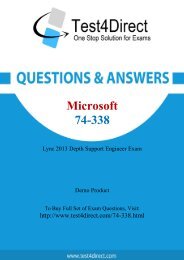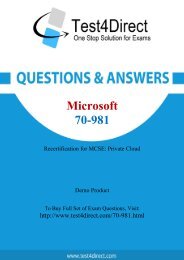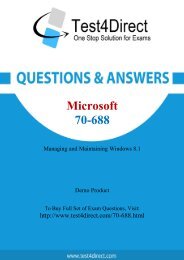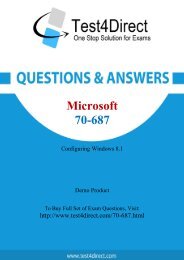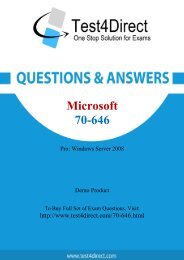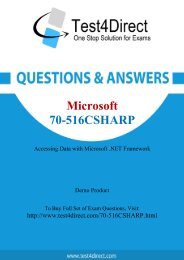70-410 BrainDumps
Test4Direct provides latest PDF questions of Microsoft 70-410 exam. You have an opportunity to pass the Microsoft 70-410 exam in one go. Test4Direct is most accurate source to prepare Microsoft 70-410 exam as your success will become site’s responsibility after purchasing 70-410 exam product. There are also lots of discounts and promotion offers that you can avail. Let’s try a free demo http://www.test4direct.com/70-410.html
Test4Direct provides latest PDF questions of Microsoft 70-410 exam. You have an opportunity to pass the Microsoft 70-410 exam in one go. Test4Direct is most accurate source to prepare Microsoft 70-410 exam as your success will become site’s responsibility after purchasing 70-410 exam product. There are also lots of discounts and promotion offers that you can avail. Let’s try a free demo http://www.test4direct.com/70-410.html
You also want an ePaper? Increase the reach of your titles
YUMPU automatically turns print PDFs into web optimized ePapers that Google loves.
Microsoft<br />
<strong>70</strong>-<strong>410</strong><br />
Installing and Configuring Windows Server 2012<br />
Demo Product<br />
To Buy Full Set of Exam Questions, Visit:<br />
http://www.test4direct.com/<strong>70</strong>-<strong>410</strong>.html
Question: 1<br />
You have a server named Server1 that runs Windows Server 2012 R2. Server1 has the Hyper-V server<br />
role installed.<br />
An iSCSI SAN is available on the network.<br />
Server1 hosts four virtual machines named VM1, VM2, VM3, and VM4.<br />
You create a LUN on the SAN to host the virtual hard drive files for the virtual machines.<br />
You need to create a 3-TB virtual hard disk for VM1 on the LUN. The solution must prevent VM1 from<br />
being paused if the LUN runs out of disk space.<br />
Which type of virtual hard disk should you create on the LUN?<br />
A. Dynamically expanding VHDX<br />
B. Fixed-size VHDX<br />
C. Fixed-size VHD<br />
D. Dynamically expanding VHD<br />
Question: 2<br />
Answer: B<br />
Explanation:<br />
The virtual disk needs to be a VHDX file since it is going to be over 2TB in size and it must be fixedsize<br />
so that the space is already taken on the server (that way the server does not run out of space as<br />
the volume grows) even if the actual virtual disk does not yet hold that amount of data.<br />
Your network contains an Active Directory domain named adatum.com. The domain contains a<br />
member server named Host1. Host1 runs Windows Server 2012 R2 and has the Hyper-V server role<br />
installed.<br />
Host1 hosts two virtual machines named VM5 and VM6. Both virtual machines connect to a virtual<br />
switch named Virtual1.<br />
On VM5, you install a network monitoring application named Monitor1.<br />
You need to capture all of the inbound and outbound traffic to VM6 by using Monitor1.<br />
Which two commands should you run from Windows PowerShell? (Each correct answer presents<br />
part of the solution. Choose two.)<br />
A. Get-VM “VM6″ | Set-VMNetworkAdapter-IovWeight 1<br />
B. Get-VM “VM5″ I Set-VMNetworkAdapter -IovWeight 0<br />
C. Get-VM “VM5″ | Set-VMNetworkAdapter -PortMirroring Source<br />
D. Get-VM “VM6″ | Set-VMNetworkAdapter -AllowTeaming On<br />
E. Get-VM “VM6″ | Set-VMNetworkAdapter -PortMirroring Destination<br />
F. Get-VM “VM5″ | Set-VMNetworkAdapter -AllowTeaming On<br />
Answer: C, E<br />
Explanation:<br />
-PortMirroring specifies the port mirroring mode for the network adapter. This can be set to None,<br />
Source, and Destination.
If set to Source, a copy of every network packet it sends or receives is forwarded to a virtual network<br />
adapter configured to receive the packets.<br />
If set to Destination, it receives copied packets from the source virtual network adapter.<br />
In this scenario, VM5 is the destination which must receive a copy of the network packets from VM6,<br />
which s the source.<br />
Reference: http://technet.microsoft.com/en-us/library/hh848457.aspx<br />
Question: 3<br />
You have a Hyper-V host named Server1 that runs Windows Server 2012 R2.Server1 has the virtual<br />
switches listed in the following table.<br />
You create a virtual machine named VM1.VM1 has two network adapters. One network adapter<br />
connects to vSwitch1. The other network adapter connects to vSwitch2.You configure NIC teaming on<br />
VM1.<br />
You need to ensure that if a physical NIC fails on Server1, VM1 remains connected to the network.<br />
What should you do on Server1?<br />
A. Run the Set-VmNetworkAdaptercmdlet.<br />
B. Add a new network adapter to VM1.<br />
C. Create a new virtual switch on Server 1.<br />
D. Modify the properties of vSwitch1 and vSwitch2.<br />
Question: 4<br />
Question: 5<br />
Answer: A<br />
Your network contains two Hyper-V hosts that run Windows Server 2012 R2. The Hyper-V hosts<br />
contain several virtual machines that run Windows Server 2012 R2.<br />
You install the Network Load Balancing feature on the virtual machines.<br />
You need to configure the virtual machines to support Network Load Balancing (NLB).<br />
Which virtual machine settings should you configure?<br />
A. DHCP guard<br />
B. Port mirroring<br />
C. Router guard<br />
D. MAC address<br />
Answer: D<br />
Explanation:<br />
http://social.technet.microsoft.com/Forums/windowsserver/en -US/5b3a0a9d-26a2-49ba-bbbe-<br />
29d11fcbb7ce/nlb-on-hyperv?forum=winserverhyperv<br />
For NLB to be configured you need to enable MAC address spoofing.
You have a server named Server1 that runs Windows Server 2012 R2. Server1 has the Hyper-V server<br />
role installed. Server1 is connected to two Fibre Channel SANs and is configured as shown in the<br />
following table.<br />
You have a virtual machine named VM1.<br />
You need to configure VM1 to connect to SAN1.<br />
What should you do first?<br />
A. Add one HBA<br />
B. Create a Virtual Fibre Channel SAN.<br />
C. Create a Hyper-V virtual switch.<br />
D. Configure network adapter teaming.<br />
Answer: B<br />
Explanation:<br />
You need your virtualized workloads to connect easily and reliably to your existing storage arrays.<br />
Windows Server 2012 provides Fibre Channel ports within the guest operating system, which allows<br />
you to connect to Fibre Channel directly from within virtual machines. This feature protects your<br />
investments in Fibre Channel, enables you to virtualize workloads that use direct access to Fibre<br />
Channel storage, allows you to cluster guest operating systems over Fibre Channel, and provides an<br />
important new storage option for servers hosted in your virtualization infrastructure.<br />
With this Hyper-V virtual Fibre Channel feature, you can connect to Fibre Channel storage from<br />
within a virtual machine. This allows you to use your existing Fibre Channel investments to support<br />
virtualized workloads.<br />
Support for Fibre Channel in Hyper-V guests also includes support for many related features, such as<br />
virtual SANs, live migration, and MPIO.
Question: 6<br />
Your network contains an Active Directory domain named contoso.com. The domain contains a<br />
server named Server1. Server1 runs Windows Server 2012 R2 and has the Hyper-V server role<br />
installed.<br />
On Server1, you create and start a virtual machine named VM1. VM1 is configured as shown in the<br />
following table.<br />
You need to recommend a solution to minimize the amount of disk space used for the checkpoint of<br />
VM1.<br />
What should you do before you create the checkpoint?<br />
A. Run the Resize-VHD cmdlet.<br />
B. Convert Disk1.vhd to a dynamically expanding disk.<br />
C. Shut down VM1.<br />
D. Run the Convert-VHD cmdlet.<br />
Question: 7<br />
Answer: C<br />
Explanation:<br />
Changing between a fixed and dynamic disk type does not alter the size of a SNAPSHOT much at all.<br />
However, since a snapshot is a record of a VMs state at the exact time that the snapshot was taken,<br />
shutting down the VM before taking the snapshot prevents the snapshot from having to contain all of<br />
the data in RAM (as there is no data in memory when a machine is powered down).<br />
The question states that the solution should minimize the amount of disk space used for the<br />
checkpoint of VM1. If the checkpoint is taken while VM1 is running, there will be two attritional files<br />
present at the checkpoint location; a .VSV with VM1 saved state files and a .BIN file which contains<br />
VM1’s memory contents. If, however, VM1 is shut down first, these files will not be created, thus<br />
saving disk space.<br />
In order to convert Disk1.vhd to a dynamically expanding disk, VM1 still have to be shut down.<br />
HOTSPOT<br />
You have a Hyper-V host named Hyperv1 that runs Windows Server 2012 R2. Hyperv1 hosts a virtual<br />
machine named Server1. Server1 uses a disk named Server1.vhdx that is stored locally on Hyperv1.<br />
You stop Server1, and then you move Server1.vhdx to an iSCSI target that is located on another<br />
server.<br />
You need to configure Server1 to meet the following requirements:<br />
Ensure that Server1 can start by using Server1.vhdx.<br />
Prevent Server1.vhdx from consuming more than 500 IOPS on the iSCSI target.<br />
Which two objects should you configure?<br />
To answer, select the appropriate two objects in the answer area.
Answer:<br />
Question: 8<br />
You have a print server named Server1 that runs Windows Server 2012 R2.<br />
You discover that when there are many pending print jobs, the system drive occasionally runs out of<br />
free space.<br />
You add a new hard disk to Server1.You create a new NTFS volume.<br />
You need to prevent the print jobs from consuming disk space on the system volume.<br />
What should you modify?<br />
A. The properties on the new volume<br />
B. The properties of the Print Spooler service<br />
C. The Print Server Properties<br />
D. The properties of each shared printer<br />
Question: 9<br />
Answer: C<br />
Explanation:<br />
Windows spools print jobs by default to the following directory as they are processed:<br />
%SystemRoot%\SYSTEM32\SPOOL\PRINTERS.<br />
It is possible for the administrator of a Windows print server to manually instruct Windows the<br />
location for placing the spool files, if for example there is a concern for disk space.
HOTSPOT<br />
A printer named Printer1 is configured as shown in the exhibit. (Click the Exhibit button.)<br />
To answer, complete each statement according to the information presented in the exhibit. Each<br />
correct selection is worth one point.
Answer:<br />
Explanation:<br />
* The printer is paused.<br />
* Jobs can always be permitted (even if the printer is paused, or printer not started).<br />
Note:<br />
StartTime<br />
Date and time that a printer can start to print a job — if the printer is limited to print at specific<br />
times. This value is expressed as the time elapsed since 12:00 AM GMT (Greenwich Mean Time).<br />
This is sort of a trick question. As it stands, when the PowerShell script was executed, the printer is in<br />
"Paused" status, so any submitted job will go to the queue and remain there until the status is<br />
"Available". As for the ability to submit a job, a user can SUBMIT the job at any time. If it is outside of<br />
the printer's availability range, it will simply remain in the queue until the printer's start time is<br />
reached.<br />
Question: 10<br />
HOTSPOT<br />
Your network contains an Active Directory domain named contoso.com. The domain contains a print<br />
server named Server1 that runs Windows Server 2012 R2.<br />
You share several printers on Server1.<br />
You need to ensure that you can view the printer objects associated to Server1 in Active Directory<br />
Users and Computers.<br />
Which option should you select?<br />
To answer, select the appropriate option in the answer area.
Answer:<br />
Explanation:<br />
You can view printer objects in Active Directory by clicking Users, Groups, and Computers as<br />
containers from the View menu in the Active Directory Users and Computers snap-in. By default,<br />
printer objects are created under the machine object in which they are shared. After you turn on the<br />
Users, Groups, and Computers as containers option, you can see printers by expanding the printer's<br />
host computer.<br />
Reference: http://supportHYPERLINK "http://support.microsoft.com/kb/235925#_blank".HYPERLINK<br />
"http://support.microsoft.com/kb/235925#_blank"microsoftHYPERLINK<br />
"http://support.microsoft.com/kb/235925#_blank".comHYPERLINK<br />
"http://support.microsoft.com/kb/235925#_blank"/kb/235925<br />
Question: 11<br />
HOTSPOT<br />
You have a shared folder named Share1. The folder permissions of Share1 are configured as shown in<br />
the Folder Permissions exhibit. (Click the Exhibit button.)
The Share permissions of Share1 are configured as shown in the Share Permissions exhibit. (Click the<br />
Exhibit button.)<br />
You have a group named Group1. The members of Group1 are shown in the Group1 exhibit. (Click<br />
the Exhibit button.)<br />
Select Yes if the statement can be shown to be true based on the available information; otherwise
select No. Each correct selection is worth one point.<br />
Answer:<br />
Explanation:<br />
NTFS permissions control access to the files and folders stored on disk volumes formatted with the<br />
NTFS file system. Share permissions control access to folders over a network. To access a file over a<br />
network, a user must have appropriate share permissions (and appropriate NTFS permissions if the<br />
shared folder is on an NTFS volume).Granting a user Full Control NTFS permission on a folder enables<br />
that user to take ownership of the folder unless the user is restricted in some other way.User1 was<br />
not granted Full Control permission.<br />
The Administrators have Full Control permission. I assume that User2 is an administrator since the<br />
Group1 exhibit shows only User1 as a member.<br />
References: http://technetHYPERLINK "http://technet.microsoft.com/enus/library/cc754178.aspx#_blank".HYPERLINK<br />
"http://technet.microsoft.com/enus/library/cc754178.aspx#_blank"microsoftHYPERLINK<br />
"http://technet.microsoft.com/enus/library/cc754178.aspx#_blank".comHYPERLINK<br />
"http://technet.microsoft.com/enus/library/cc754178.aspx#_blank"/en-us/library/cc754178HYPERLINK<br />
"http://technet.microsoft.com/en-us/library/cc754178.aspx#_blank".HYPERLINK<br />
"http://technet.microsoft.com/en-us/library/cc754178.aspx#_blank"aspx<br />
Exam Ref <strong>70</strong>-<strong>410</strong>: Installing and configuring Windows Server 2012 R2, Chapter 2: Configure server<br />
roles and features, Objective 2.1: Configure file and share access, p.75-80<br />
Question: 12<br />
Your network contains an Active Directory domain named adatum.com. The domain contains a<br />
server named Server1 that runs Windows Server 2012 R2.
On a server named Core1, you perform a Server Core Installation of Windows Server 2012 R2. You<br />
join Core1 to the adatum.com domain.<br />
You need to ensure that you can use Event Viewer on Server1 to view the event logs on Core1.<br />
What should you do on Core1?<br />
A. Run the Disable NetFirewallRule cmdlet.<br />
B. Install Remote Server Administration Tools (RSAT).<br />
C. Install Windows Management Framework.<br />
D. Run the Enable-Com + Network Access Firewall Rule.<br />
Question: 13<br />
Question: 14<br />
Answer: D<br />
Explanation:<br />
Information regarding IPsec policy changes, etc. can be found in the Event Viewer. Thus you need to<br />
enable the NetFirewallRule command. This will allow you to view the event logs.<br />
Your network contains two servers named Server1 and Server2 that run Windows Server 2012 R2.<br />
Server1 and Server2 are part of a workgroup.<br />
On Server1 and Server2, you create a local user account named Admin1.You add the account to the<br />
local Administrators group. On both servers, Admin1 has the same password.<br />
You log on to Server1 as Admin1. You open Computer Management and you.connect to Server2.<br />
When you attempt to create a scheduled task, view the event logs, and manage the shared folders,<br />
you receive Access Denied messages.<br />
You need to ensure that you can administer Server2 remotely from Server1 by using Computer<br />
Management.<br />
What should you configure on Server2?<br />
A. From Server Manager, modify the Remote Management setting.<br />
B. From Local Users and Groups, modify the membership of the Remote Management Users group.<br />
C. From Windows Firewall, modify the Windows Management Instrumentation (WMI) firewall rule.<br />
D. From Registry Editor, configure the LocalAccountTokenFilterPolicy registry value.<br />
Answer: D<br />
Explanation:<br />
The LocalAccountTokenFilterPolicy setting affects how administrator credentials are applied to<br />
remotely administer the computer.<br />
Reference: http://support.microsoft.com/kb/942817<br />
HOTSPOT<br />
You have a print server named Server1 that runs Windows Server 2012 R2.<br />
On Server1, you create and share a printer named Printer1.<br />
The Advanced settings of Printer1 are shown in the Advanced exhibit. (Click the Exhibit button.)
The Security settings of Printer1 are shown in the Security exhibit. (Click the Exhibit button.)<br />
The Members settings of a group named Group1 are shown in the Group1 exhibit. (Click the Exhibit<br />
button.)
Select Yes if the statement can be shown to be true based on the available information; otherwise<br />
select No. Each correct selection is worth one point.<br />
Answer:<br />
Question: 15<br />
Your network contains a server named Server1 that runs Windows Server 2012 R2.Server1 has the<br />
Hyper-V server role installed.<br />
Server1 hosts four virtual machines named VM1, VM2, VM3, and VM4.<br />
Server1 is configured as shown in the following table.<br />
You install Windows Server 2012 R2 on VM2 by using Windows Deployment Services (WDS).<br />
You need to ensure that the next time VM2 restarts, you can connect to the WDS server by using PXE.<br />
Which virtual machine setting should you configure for VM2?
A. NUMA topology<br />
B. Resource control<br />
C. resource metering<br />
D. virtual Machine Chimney<br />
E. The VLAN ID<br />
F. Processor Compatibility<br />
G. The startup order<br />
H. Automatic Start Action<br />
I. Integration Services<br />
J. Port mirroring<br />
K. Single-root I/O virtualization<br />
Answer: G<br />
Explanation:<br />
Configure the BIOS of the computer to enable PXE boot, and set the boot order so that it is booting<br />
from the network is first.<br />
References: http://technet.microsoft.com/en-us/library/cc766320(v=ws.10).aspx<br />
Exam Ref <strong>70</strong>-<strong>410</strong>, Installing and Configuring Windows Server 2012 R2, Chapter 3: Configure Hyper-V,<br />
Objective 3.1: Create and Configure virtual machine settings, p.144<br />
Training Guide: Installing and Configuring Windows Server 2012 R2: Chapter 7: Hyper-V<br />
Virtualization, Lesson 2: Deploying and configuring virtual machines, p.335
THANKS FOR TRYING THE DEMO OF OUR PRODUCT<br />
Visit Our Site to Purchase the Full Set of Actual <strong>70</strong>-<strong>410</strong> Exam Questions With Answers.<br />
http://www.test4direct.com/<strong>70</strong>-<strong>410</strong>.html<br />
We Also Provide Practice Exam Software That Simulates Real Exam Environment And Has<br />
Many Self-Assessment Features. Download Free Product Demo From:<br />
http://www.test4direct.com/<strong>70</strong>-<strong>410</strong>.html<br />
Money Back Guarantee<br />
Check Out Our Customer Testimonials


